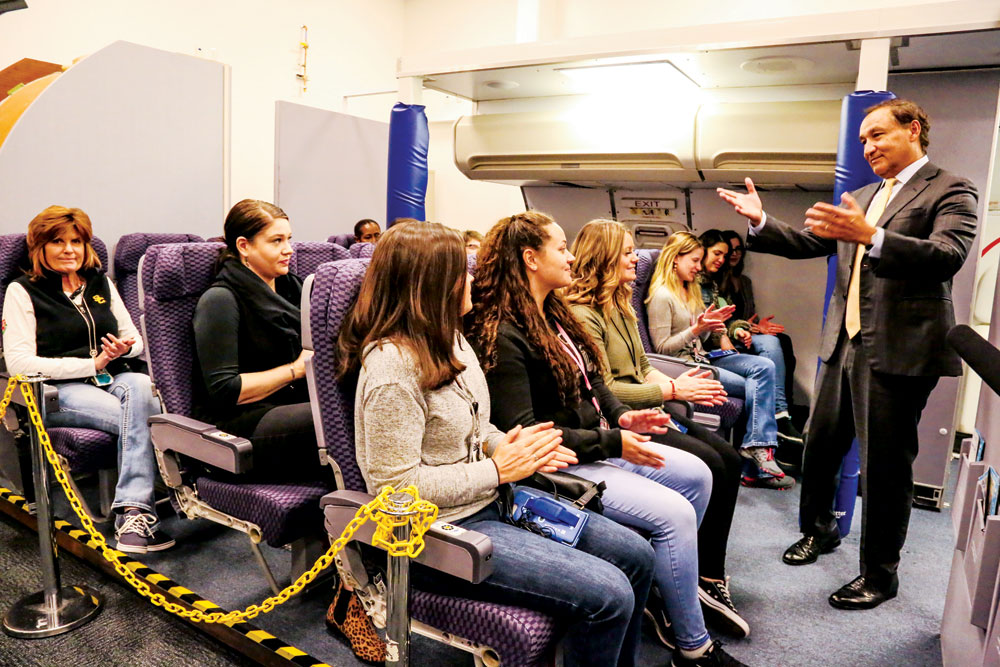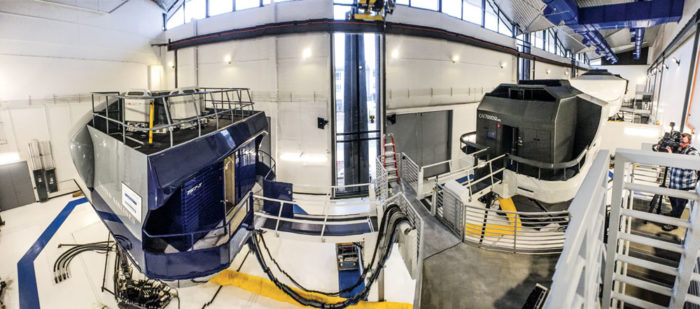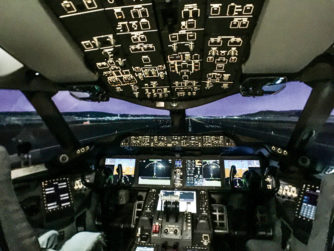
United CEO Oscar Muñoz, while at the United Flight Training Center on Quebec St. to celebrate its expansion, stops in to the mock aircraft cabin to speak to flight attendant trainees. “We are a people to people business. We’re not a products company,” he tells them. “If we get the human interaction part right, and YOU help me with that, no one stops us.” United is currently the fastest growing airline in the world.
The largest flight training center in the world is our NE Denver neighbor at Quebec St. and 35th Ave. All of United’s 12,500 pilots come here for their recurring two-day training every nine months. That’s 60,000 training events each year. In one of 31 full motion simulators that exactly reproduce United’s cockpits, “They practice all the things we don’t like to talk about. Engine failure, hydraulics failure. All the things you want to do in a simulator that you don’t want to do in a real airplane,” says Captain Mike McCasky, managing director of flight training.

Captain Mike McCasky, managing director of flight training, explains that the 30-day training for new United pilots starts in this room where they learn systems, take an exam, then move on to fixed training devices, and take another exam. Finally they move to the full flight simulators, where they complete their training.
Thousands of drivers pass the United Airlines Flight Training Center each day without a clue as to the buzz of activity that takes place inside 24 hours a day—other than seeing pilots crossing the street, sometimes at odd hours, to get to their hotels.
The range of activities includes regularly recurring training for every United pilot and for southwest area flight attendants, a 30-day training program for all new pilots, training for new flight attendants, and technical operations training for mechanics.
Captain Mike McCasky, managing director of flight training, says the training is scheduled in shifts and the simulators are in use 90+% of the time. A crew comes to their briefing room at 8am, leaves the room at 9:30am, and goes in the simulator at 10am. They finish at 2pm. At noon the next crew shows up and goes through the briefing, so the facilities are always being used. McCasky adds that the 10pm to 2am shift is not the most popular, but they do the “lower motor skills training then and things that require more acuity at better times.” View video here: https://vimeo.com/297364394

The full flight simulators (FFS) are dispersed in the “wings” of the H-shaped building so if an electrical fire or other emergency event should occur, simulators in other wings wouldn’t be affected. FFS’s are precisely arranged so that at their maximum movement, they won’t come in contact with one another or the building.
McCasky says their goal is to have pilots respond to any emergency or situation exactly the way they train. “We spend a lot of time on procedures and communication. I can get off a flight from Denver to Chicago and get on a different flight with a different crew—and never see the first pilot again. That’s how procedurized and regimented our training is. Those same expectations exist for our flight attendants. Dialogue between pilots and flight attendants is standardized so there’s no confusion along the way.”

Left and center: A replica of the exit door for every model of plane flown by United is used in training flight attendants. Pilots fly only one model of aircraft, but flight attendants work on numerous aircraft and need to be trained on all of them. Right: A trip down this 757 exit slide replica gives pilots and flight attendants a first-person experience during their emergency training. This room also has different models of fire extinguishers, life vests, oxygen masks, and other emergency equipment on board the different models of aircraft.

United CEO Oscar Muñoz (right), at the United renovation celebratory event, said, “We have many airport authorities we interact with. There’s a reason why this facility is in Denver. It is the pro business environment…and the way the mayor and the governor work together… This is one of the great partnerships that we’ve seen. The lease we signed in 2014 extends to 2035. We’ve sunk a quarter of a billion dollars in this place. We love being here.”
Mayor Hancock said, “Thank you United for what you’ve done to lift this region up.” He told the crowd he respects Muñoz as a person and as a CEO—and that Denver’s relationship with United has helped identify global opportunities and attract companies to Denver.
City Councilman Chris Herndon is pictured in the background.
In talking to the flight attendants, CEO Muñoz addressed a difficult aspect of their job—complying with the standardization and rigidity necessary for safety, while at the same time being in a “people business” where graciousness and hospitality are critical.
The original campus was constructed in 1968 and has had multiple additions. It currently has 462,000 square feet of space. Construction on another 100,000 square foot wing of the H-shaped building is visible on the southwest corner of the campus and will be completed in about a year.
The new wing will add 8 full flight simulators to the 31 they already have—and 4 fixed training devices will be added to the 10 they already have. McCasky describes the full flight simulators as “finicky.” They don’t like electrical spikes and need to be in a room where the proper constant temperature is maintained.
United’s Denver Flight Training Center had 500 employees before the Houston consolidation in January 2017. It now has 800 employees—and is growing.

The cockpit so precisely matches a real cockpit that after 30 days, a newly hired pilot is ready to fly with passengers.


0 Comments